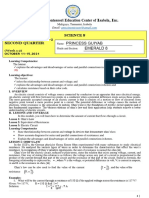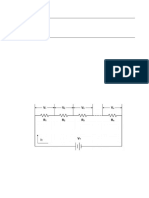Electronics Lab 6
Uploaded by
aneesafatima432Electronics Lab 6
Uploaded by
aneesafatima432_________________________________________________________________________
TITLE : Study of VDR & Series, CDR & Parallel Circuit
DATE OF
:
EXPERIMENT
LAB NUMBER : 02
INSTRUCTOR :
: _________________________
SUBMITTED BY __
_________________________
ROLL NO :
Electronics-I Lab Page 1
_________________________________________________________________________
Task 1: Series circuit
Objective:
The objective of this experiment is to analyze simple resistive circuits in DC. The
circuits considered here are: resistors in series, resistors in parallel. This experiment
will allow the experimental verification of the theoretical analysis.
Theory:
The theoretical analysis of the circuits under study is based on Ohm’s and Kirchoff’s
laws. The main equations relating the electrical parameters of each circuit are
presented next.
Ohm’s law:
The voltage V (in volts, V) across a resistor is directly proportional to the current I (in
amperes, A) flowing through it. The constant of proportionality is the resistance R (in
ohms).
Resistors in series:
An example of resistors connected in series is shown in figure 2.1.
• The current through N elements in series is the same for all of them.
• The voltage across the ith element is Vi=Ri Ii. The sum of the voltages across
each element is equal to the voltage applied to the entire series combination.
• The equivalent
resistance of the series
combination is the sum of the individual resistance.
Analysis:
Calculate the percentage error between the measured and theoretical data and
complete all the entries in Tables 2-1. The percentage error is given by:
Where dth and dm are the theoretical and measured
data respectively.
Electronics-I Lab Page 2
_________________________________________________________________________
Voltage divider rule (VDR):
Voltage divider rule, This voltage divider produces an output voltage, Vout, that is
proportional to the input voltage, V1. The output voltage is measured using a voltmeter.
The input voltage is the voltage of the voltage source. The constant of proportionality is
called the gain of the voltage divider. The value of the gain of the voltage divider is
determined by the resistances, R1,R2 and R3, of the three resistors that comprise the
voltage divider as shown in Figure 2-1. Observe how the Digital Multimeter is connected
to the output terminals of the circuit
Vout = _R2_ x Vin
RT
Circuit Diagram:
Figure: 2-1
Observations and Calculations:
Table 1:
Parameters R1 R2 R3 Req. VS VR1 VR2 VR3 IS or IT
Units KΩ Volts mA
Electronics-I Lab Page 3
_________________________________________________________________________
Theoretical 1 2.2 5.6 8.8 10
Experimental 1 2.0 5.7 8.7 --
Error % --
Hardware Attempts:
Software Attempts:
Electronics-I Lab Page 4
_________________________________________________________________________
Task 2: Parallel Circuits
Objective:
The objective of this experiment is to analyze simple resistive circuits in DC. The
circuits considered here are: resistors in parallel, resistors in Combinational. This
experiment will allow the experimental verification of the theoretical analysis.
Theory:
The theoretical analysis of the circuits under study is based on Ohm’s and Kirchhoff’s
laws. The main equations relating the electrical parameters of each circuit are
presented next.
Ohm’s law:
The voltage V (in volts, V) across a resistor is directly proportional to the current I (in
amperes, A) flowing through it. The constant of proportionality is the resistance R (in
ohms).
Resistors in parallel:
An example of resistors connected in parallel is shown in figure3.2.
• The voltage across N elements in parallel is the same for all of them.
Electronics-I Lab Page 5
_________________________________________________________________________
• The current through the ith element is Ii=Vi/Ri.The sum of the currents
through each element is equal to the current provided to the entire parallel
combination.
• The reciprocal of the equivalent
resistance of the parallel
combination is the sum of the reciprocal of the individual resistances.
Current divider rule (CDR):
In electronics, a current divider is a simple linear circuit that produces an
output current (IX) that is a fraction of its input current (IT). Current division refers
to the splitting of current between the branches of the divider. The currents in the
various branches of such a circuit will always divide in such a way as to minimize the
total energy expended.
The formula describing a current divider is similar in form to that for the voltage
divider. However, the ratio describing current division places the impedance of the
unconsidered branches in the numerator, unlike voltage division where the
considered impedance is in the numerator. This is because in current dividers, total
energy expended is minimized, resulting in currents that go through paths of least
impedance, therefore the inverse relationship with impedance. On the other hand,
voltage divider is used to satisfy Kirchhoff's Voltage Law. The voltage around a loop
must sum up to zero, so the voltage drops must be divided evenly in a direct
relationship with the impedance.
Electronics-I Lab Page 6
_________________________________________________________________________
Figure: 3-1
Analysis:
Calculate the percentage error between the measured and theoretical data and
complete all the entries in Tables 3-1. The percentage error is given by:
Where dth and dm are the theoretical and measured
data respectively.
With simple parallel circuits, all components are connected between the same two
sets of electrically common points, creating multiple paths for electrons to flow from
one end of the battery to the other.
Figure: 3-2
Observations and Calculations:
Table 3-1:
Parameters R1 R2 R3 Req. VS IR1 IR2 IR3 IS or IT
Units KΩ Volts mA
Theoretical 1 2.2 5.6 10
Experimental --
Error % --
Electronics-I Lab Page 7
_________________________________________________________________________
Hardware Attempts:
Software Attempts:
Electronics-I Lab Page 8
You might also like
- Experiment # 10 Study and Implementation of Series DC Circuit Using MultisimNo ratings yetExperiment # 10 Study and Implementation of Series DC Circuit Using Multisim5 pages
- Faculty of Electrical Engineering Universiti Teknologi MaraNo ratings yetFaculty of Electrical Engineering Universiti Teknologi Mara9 pages
- Labs For Verification of Ohms Law Series and Parallel CircuitsNo ratings yetLabs For Verification of Ohms Law Series and Parallel Circuits9 pages
- ACTIVITY 2 - Verification of VDT and CDTNo ratings yetACTIVITY 2 - Verification of VDT and CDT5 pages
- Faculty of Electrical Engineering Universiti Teknologi MaraNo ratings yetFaculty of Electrical Engineering Universiti Teknologi Mara9 pages
- Electronic Circuit Style CV by SlidesgoNo ratings yetElectronic Circuit Style CV by Slidesgo32 pages
- Experiment C_ Voltage and Current DividersNo ratings yetExperiment C_ Voltage and Current Dividers11 pages
- Department of Physics, de La Salle University 2401 Taft Avenue, Manila, Philippines 1004No ratings yetDepartment of Physics, de La Salle University 2401 Taft Avenue, Manila, Philippines 10048 pages
- Measurement of DC Voltage and Current: by Matthew Trowbridge With Joseph Pate and Jared Gentry January 28, 2014No ratings yetMeasurement of DC Voltage and Current: by Matthew Trowbridge With Joseph Pate and Jared Gentry January 28, 20144 pages
- Experiment On: Measurement of DC Currents, Voltage, Resistances and Study of Resistance Colour CodeNo ratings yetExperiment On: Measurement of DC Currents, Voltage, Resistances and Study of Resistance Colour Code8 pages
- Module 4 Simple Resistive Circuit For StudentsNo ratings yetModule 4 Simple Resistive Circuit For Students32 pages
- Chaptre1 Main Theorems For Electrical Network AnalysisNo ratings yetChaptre1 Main Theorems For Electrical Network Analysis21 pages
- Calculating Current, Voltage, Resistance and PowerNo ratings yetCalculating Current, Voltage, Resistance and Power7 pages
- Introduction To Waves Education Presentation in 0 Green Style 20240924 121733 0000No ratings yetIntroduction To Waves Education Presentation in 0 Green Style 20240924 121733 000024 pages
- Ecef1024: Fundamental of Physics Lab Practical 1: Resistance in Series and ParallelNo ratings yetEcef1024: Fundamental of Physics Lab Practical 1: Resistance in Series and Parallel6 pages
- Activity No. 2: Voltage Divider and Current Divider Circuit DesignNo ratings yetActivity No. 2: Voltage Divider and Current Divider Circuit Design5 pages
- Lab Activity 2: Verification of Voltage and Current Division TheoremsNo ratings yetLab Activity 2: Verification of Voltage and Current Division Theorems5 pages
- Ch-2 Electrical Circuit anlysis-PART 1 (2)No ratings yetCh-2 Electrical Circuit anlysis-PART 1 (2)48 pages
- Controlst Software Suite: Installation, Upgrade, and Compatibility GuideNo ratings yetControlst Software Suite: Installation, Upgrade, and Compatibility Guide78 pages
- 512 Kbit (64K x8) UV EPROM and OTP EPROM: FeaturesNo ratings yet512 Kbit (64K x8) UV EPROM and OTP EPROM: Features19 pages
- ABAP Proxy (Complete Developments On SAP-PI &am..No ratings yetABAP Proxy (Complete Developments On SAP-PI &am..7 pages
- Processor's Performance: Parth Shah Parthshah - Ce@charusat - Ac.inNo ratings yetProcessor's Performance: Parth Shah Parthshah - Ce@charusat - Ac.in49 pages
- Software Architecture and Design Assignment #3: University of Lahore, Sargodha CampusNo ratings yetSoftware Architecture and Design Assignment #3: University of Lahore, Sargodha Campus13 pages
- Ti 278910320 Sollwertwandler en 1122 DeskNo ratings yetTi 278910320 Sollwertwandler en 1122 Desk3 pages
- Power Electronics - Waveforms and FormulaeNo ratings yetPower Electronics - Waveforms and Formulae13 pages
- Veritas Netbackup ™ Enterprise Server and Server 8.0 - 8.X.X Os Software Compatibility ListNo ratings yetVeritas Netbackup ™ Enterprise Server and Server 8.0 - 8.X.X Os Software Compatibility List84 pages
- Best Laptops & Ultrabooks Under Rs 50 - 000 in India - July 2016No ratings yetBest Laptops & Ultrabooks Under Rs 50 - 000 in India - July 201615 pages
- Experiment # 10 Study and Implementation of Series DC Circuit Using MultisimExperiment # 10 Study and Implementation of Series DC Circuit Using Multisim
- Faculty of Electrical Engineering Universiti Teknologi MaraFaculty of Electrical Engineering Universiti Teknologi Mara
- Labs For Verification of Ohms Law Series and Parallel CircuitsLabs For Verification of Ohms Law Series and Parallel Circuits
- Faculty of Electrical Engineering Universiti Teknologi MaraFaculty of Electrical Engineering Universiti Teknologi Mara
- Department of Physics, de La Salle University 2401 Taft Avenue, Manila, Philippines 1004Department of Physics, de La Salle University 2401 Taft Avenue, Manila, Philippines 1004
- Measurement of DC Voltage and Current: by Matthew Trowbridge With Joseph Pate and Jared Gentry January 28, 2014Measurement of DC Voltage and Current: by Matthew Trowbridge With Joseph Pate and Jared Gentry January 28, 2014
- Experiment On: Measurement of DC Currents, Voltage, Resistances and Study of Resistance Colour CodeExperiment On: Measurement of DC Currents, Voltage, Resistances and Study of Resistance Colour Code
- Chaptre1 Main Theorems For Electrical Network AnalysisChaptre1 Main Theorems For Electrical Network Analysis
- Calculating Current, Voltage, Resistance and PowerCalculating Current, Voltage, Resistance and Power
- Introduction To Waves Education Presentation in 0 Green Style 20240924 121733 0000Introduction To Waves Education Presentation in 0 Green Style 20240924 121733 0000
- Ecef1024: Fundamental of Physics Lab Practical 1: Resistance in Series and ParallelEcef1024: Fundamental of Physics Lab Practical 1: Resistance in Series and Parallel
- Activity No. 2: Voltage Divider and Current Divider Circuit DesignActivity No. 2: Voltage Divider and Current Divider Circuit Design
- Lab Activity 2: Verification of Voltage and Current Division TheoremsLab Activity 2: Verification of Voltage and Current Division Theorems
- Employability Skills: Brush up Your ElectronicsFrom EverandEmployability Skills: Brush up Your Electronics
- Controlst Software Suite: Installation, Upgrade, and Compatibility GuideControlst Software Suite: Installation, Upgrade, and Compatibility Guide
- 512 Kbit (64K x8) UV EPROM and OTP EPROM: Features512 Kbit (64K x8) UV EPROM and OTP EPROM: Features
- Processor's Performance: Parth Shah Parthshah - Ce@charusat - Ac.inProcessor's Performance: Parth Shah Parthshah - Ce@charusat - Ac.in
- Software Architecture and Design Assignment #3: University of Lahore, Sargodha CampusSoftware Architecture and Design Assignment #3: University of Lahore, Sargodha Campus
- Veritas Netbackup ™ Enterprise Server and Server 8.0 - 8.X.X Os Software Compatibility ListVeritas Netbackup ™ Enterprise Server and Server 8.0 - 8.X.X Os Software Compatibility List
- Best Laptops & Ultrabooks Under Rs 50 - 000 in India - July 2016Best Laptops & Ultrabooks Under Rs 50 - 000 in India - July 2016

























































































